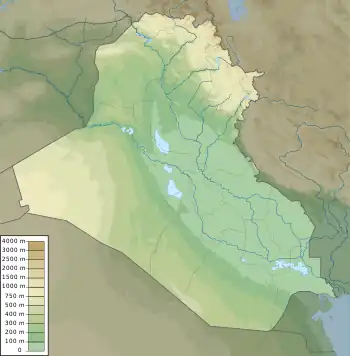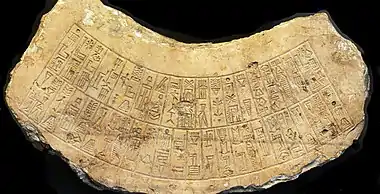 Shown within Iraq | |
| Alternative name | Tell Wannat es-Sadum |
|---|---|
| Location | Iraq |
| Coordinates | 32°05′34″N 44°47′00″E / 32.09278°N 44.78333°E |
| Type | settlement |
| Site notes | |
| Excavation dates | 1990, 2005, 2007 |
| Archaeologists | Na'el Hannoon, Abbas Al-Hussainy |
| Condition | Ruined |
| Ownership | Public |
| Public access | Yes |
Marad (Sumerian: Marda, modern Tell Wannat es-Sadum or Tell as-Sadoum (also Wana-Sedoum), Iraq) was an ancient Near Eastern city. Marad was situated on the west bank of the then western branch of the Upper Euphrates River west of Nippur in modern-day Iraq and roughly 50 km southeast of Kish, on the Arahtu River. The site was identified in 1912 based on a Neo-Babylonian inscription on a truncated cylinder of Nebuchadrezzar noting the restoration of the temple. The cylinder was not excavated but rather found by locals so its provenance was not certain, as to some extent was the site's identification as Marad.[1][2] In ancient times it was on the canal, Abgal, running between Babylon and Isin.
The city's main temple, a ziggurat, is E-igi-kalama (House which is the eye of the Land).[3] It was dedicated to Lugal-Marada (thought by some to be a manifestation of Ninurta), the tutelary deity of Marad and the god of earth and the plow, built by one of Naram-Sin's sons, .[4]
History
3rd Millennium BC

Marad was established ca. 2700 BC, during the Sumerian Early Dynastic II period. Although Marad is not mentioned in the Sumerian King List and in the earliest city lists, it does appear in the temple hymns of the Early Dynastic period praising the city god of Marad, lugal-Marada. The city god of Kazallu, Numushda, is also sometimes mentioned in contracts, though another nearby town, Kiritab, also had Numushda as its titular god so this is not certain. It was ruled by the Akkadian Empire, after its capture by Sargon of Akkad, under a governor. Confirmation of the site as Marad came with four inscribed door sockets found during the excavation at Tell as-Sadoum. They recorded that Lipit-ilē governor at Marad and the son of king Naram-Sin, fourth ruler of the Akkadian Empire, built a temple to the god Lugal-Marda at Marad:
"Naram-Sin, the mighty, king of the four quarters, victor in nine battles in one year: After he was victorious in those battles, he captured their three kings and brought (them) before the god Enlil, At that time, Lipit-ilē, his son, governor of Marad, built the temple of the god Lugalmarda at Marad. As for the one who removes this inscription, may the gods Samas and Lugalmarda tear out his foundation and destroy his progeny."[5][6]
After the fall of that empire Marad fell under the sway of the Ur III empire, again via a governor. The city was briefly under the control of Elam under until Elam fell to Ur with the first Ur III ruler, Ur-Nammu writing "Then: Umma, Marda, Šubur, Kazallu, and their settlements, and whatsoever was oppressed by Anšan, verily, I established their freedom".[7] In 1920 a researcher purchased a small tablet "from a little Arab boy in the ruins of Babylon" dated to 3rd year of Amar-Sin, 3rd ruler of the Ur III empire. Lishanum was also mentioned in a Drehem tablet as a governor of an unknown city in the 5th year of Amar-Sin.
"Thirty-six fat sheep, twenty-eight sheep, the regular offering assessed as the tax of Lishanum Patesi of Marad, from Dungiurumu, on the twenty-ninth day, as a contribution, Abbasbagga [receiv]ed. Month Kisig-Ninazu, year when the great high priest of Anna appointed the priest of Nannar" (fourth year of Bur-Sin)."[8]
Old Babylonian period

After control by Isin for a time Marad had a brief period of independence before it was captured by Babylon. Some illicitly excavated tablets from this period appeared on the antiquities market, primarily a family archive of an economic nature. Known kings from that independent period are Halun-pi-umu, Sumu-ditana, Sumu-atar, Sumu-numhim, and Yamsi-el.[9] In Old Babylonian times Marad is often mentioned together with Kazallu. It is believed that they were part of the same kingdom.[10] Marad was also occupied in Neo-Babylonian times. Nebuchadnezzar II (605-562 BC) reports rebuilding the temple of Lugal-Marada:
"At that time for Lugal-Marada, my lord, his temple which is in Marada, whose ancient foundation platform no former king had seen since the days of old, its ancient foundation platform I sought and beheld, and upon the platform of King Naram-Sin, my ancient ancestor, I fixed its foundations. I made an inscription with my name and put it therein."[11]
A notable known ruler of Marad, roughly from the same time as Babylonian ruler Sumu-la-El was Alumbiumu.[12] Two year names are known, "Year Alumbiumu became king" and "Year Alumbiumu seized Dilbat". Also the 4th year name of Sumu-la-el and a matching year name of an unknown ruler of Kisurra reads "Year Alumbiumu was smitten by weapons".[13][14] A royal daughter of Alumbiumu was made nadītu at Sippar, during the reign of Sumu-la-el.[15]
Later occupation
Light occupation occurred in the Kassite (with ruler Kadashman-Turgu known to have worked on the Lugal-Marda temple) and Parthian periods.[16][17] A prebend (similar to a Benefice) document from the reign of Darius I (c. 550–486 BC) recording a sale for the temple E-igi-kalama for the god Ea which was written in Marad.[18][19]
Archaeology

The site of Marad covers an area of about 50 hectares with the main mound, at the northern edge of the site and locally called Bint ish-Shaikh, rising 14 meters above the plain.[20]
Marad was excavated by a team from the Iraqi General Directorate of Antiquities and the Qādissiyyah University in 1990 led by Na'el Hannoon, and in 2005 and 2007 led by Abbas Al-Hussainy. On the main mound a hall, thought to be a temple, was excavated on the main mound. To the west of the mound residences from the Old Babylonian period were found.[21][22] During the latter excavation a number of cuneiform tablets were discovered, mainly from the Isin-Larsa and Old Babylonian periods but a few from Neo-Babylonian times.[23] Most recently excavation occurred in Autumn 2019. A few more cuneiform tablets were found (5 complete, 3 almost complete, 8 small pieces), clay tags, and envelope fragments. The epigraphics, economic/legal in nature, included dates of Marad ruler Sumu-numhim and Babylon ruler Sumu-la-EL (years 27 and 28). After a survey, a trench was excavated in a small tell on the western end of the site which showed three occupation layers ranging from Early Dynastic III through Akkadian, Isin-Larsa and Old-Babylonian. A number of Parthian era graves were found across the site.[20]
See also
References
- ↑ Thureau-dangin, f., Bibliographie., RA 9, pp. 84, 1912
- ↑ Banks, Edgar J., "Nebuchadnezzar as a Builder", Scientific American, vol. 110, no. 15, pp. 314–20, 1914
- ↑ Dalley, Stephanie (1998) Myths from Mesopotamia: Creation, the flood, Gilgamesh, and others. Oxford University Press ISBN 0-19-283589-0 p324
- ↑ Clay, Albert T., "The Site of Marad", Orientalistische Literaturzeitung, vol. 17, no. 1-6, pp. 55-57, 1914
- ↑ Douglas Frayne, "Akkad", in Sargonic and Gutian Periods (2234-2113 BC), Toronto: University of Toronto Press, pp. 5-218, 1993 ISBN 9780802035868
- ↑ Kraus, Nicholas Larry, "Tuṭṭanabšum: Princess, Priestess, Goddess", Journal of Ancient Near Eastern History, vol. 7, no. 2, pp. 85-99, 2020
- ↑ Sharlach, Tonia. "Princely Employments in the Reign of Shulgi" Journal of Ancient Near Eastern History, vol. 9, no. 1, pp. 1-68, 2022
- ↑ Edgerton, William F., "Lishanum, Patesi of Marad", The American Journal of Semitic Languages and Literatures, vol. 38, no. 2, pp. 141–141, 1922
- ↑ Rients de Boer, "Marad in the Early Old Babylonian Period: Its Kings, Chronology, and Isin’s Influence", Journal of Cuneiform Studies, vol. 65, pp. 73–90, 2013
- ↑ Wu, Y., "Kings of Kazallu and Marad in the early OB Period", XXXIVème Rencontre Assyriologique Internationale, 221-227, 1998
- ↑ Fārūk N. H. al- Rāwī (Q113780790), "Cuneiform Inscriptions in the Collections of the John Rylands Library, University of Manchester", Iraq, vol. 62, pp. 21–63, 2000
- ↑ Yoffee, Norman, "Aspects of Mesopotamian Land Sales", American Anthropologist, vol. 90, no. 1, pp. 119–30, 1988
- ↑ Leemans, W. F., "King Alumbiumu", Journal of Cuneiform Studies, vol. 20, no. 1, pp. 48–49, 1966
- ↑ S. G. Koshurnikov, and N. Yoffee, "Old Babylonian Tablets from Dilbat in the Ashmolean Museum", Iraq, vol. 48, pp. 117–30, 1986
- ↑ Seth Richardson, "Goodbye, Princess: Iltani and the DUMU.MUNUS LUGAL", Journal of Cuneiform Studies, vol. 69, pp. 67–108, 2017
- ↑ Al Hussainy, Abbas, "Inscriptions of Nebuchadnezzar II from the Iraqi Excavations at Marad", Mesopotamia, vol. 53, pp. 49-57, 2018
- ↑ Brinkman, J. A., "Babylonia under the Kassites: Some Aspects for Consideration", Volume 1 Karduniaš. Babylonia under the Kassites 1, edited by Alexa Bartelmus and Katja Sternitzke, Berlin, Boston: De Gruyter, pp. 1-44, 2017
- ↑ Gordin, Shai, "The Cult and Clergy of Ea in Babylon", Die Welt Des Orients, vol. 46, no. 2, pp. 177–201, 2016
- ↑ Gordin, Shai, "A Glimpse into the Šumu-libši Archive: The Sociohistorical Context of a Prebend Sale from the E-kar-zaginna of Ea in Babylon and Related Texts", Zeitschrift für Assyriologie und vorderasiatische Archäologie, vol. 107, no. 1, pp. 111-124, 2017
- 1 2 Abbas, al-Hussainy, et al. "Excavations at Tell as-Sadoum, ancient Marad (Iraq). Summary report on the 2019 archaeological season." (2021), Rivista, pp. 189-218
- ↑ Al-Hussayny, A., "Some Cylinder Seals from the Iraqi Excavations at Marad, Mesopotamia", vol. 45, pp. 65-70, 2010
- ↑ Hannun, N., "The Ancient City of Marad and the Results of the Exploration at Wanna-wa-Sadoum, Sumer", vol. 49, pp. 63-86, 1997-1998 (in arabic)
- ↑ Fahad, Saad S., and Abbas A. AL-hussainy. "Two old Babylonian Texts from MARAD (Wana wa AL_Sodum)", Adab AL Rafidayn 42.63 (2012)
Further reading
- Abbas Al-Hussainy, Jacob Jawdat, Rients De Boer, "Old Babylonian Texts from Marad Found during the 2005-2007 Iraqi Excavations, Part 1", Journal Asiatique, 310, 2, pp. 161–169, 2020
- Al-Hussainy, A., "The Date Formulae of the Tablets Excavated at Tell as-Sadoum (Season 2005) and the Chronology of the Old Babylonian Kings of Marad", Ocnus 23, pp. 45–48, 2015
- D.O. Edzard, "Marad, Marda", Reallexikon der Assyriologie und Vorderasiatischen Archäologie 7, Berlin-New York, pp. 351–352, 1987-1990
- Kutscher, Raphael, "Apillaša, Governor of Kazallu", Journal of Cuneiform Studies, vol. 22, no. 3/4, pp. 63–65, 1968
- FS Safar, "Old Babylonian contracts from Marad", University of Chicago, Department of Oriental Languages and Literatures, 1938
- M. Stol, "Lugal-Marada", Reallexikon der Assyriologie und Vorderasiatischen Archäologie 7.1/2, pp. 148–149, 1987